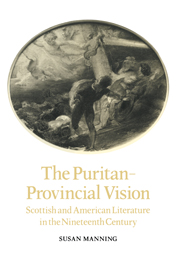Book contents
- Frontmatter
- Contents
- Preface
- Acknowledgements
- 1 Calvin's theology and the puritan mind
- 2 After Armageddon: Jonathan Edwards and David Hume
- 3 From puritanism to provincialism
- 4 The pursuit of the double
- 5 Spectators, spies and spectres: the observer's stance
- 6 ‘Is anything central?’
- Notes
- Bibliography
- Index
6 - ‘Is anything central?’
Published online by Cambridge University Press: 21 January 2010
- Frontmatter
- Contents
- Preface
- Acknowledgements
- 1 Calvin's theology and the puritan mind
- 2 After Armageddon: Jonathan Edwards and David Hume
- 3 From puritanism to provincialism
- 4 The pursuit of the double
- 5 Spectators, spies and spectres: the observer's stance
- 6 ‘Is anything central?’
- Notes
- Bibliography
- Index
Summary
The dweller in the capital knows that his city however large it may be, is only one point of the cosmos, a decentralised corner of it. He knows, further, that the world has no centre, and that it is therefore necessary, in all our judgements, to discount the peculiar perspective that reality offers when it is looked at from our own point of view. This is the reason why the provincial always thinks his neighbor of the great city a sceptic, though the fact is that the latter is only better informed.
(José Ortega y Gasset)… the phenomenon of oblique reference. Whether as humour or as allegory, this phenomenon is the same in all American writers: they walk all round the circumference of a subject and imagine they have been at the centre.
(Herbert Read)London is the epitome of our times, and the Rome of to-day.
(R.W. Emerson)In 1743, the English painter George Stubbs travelled to Rome, the cultural centre of Europe. Ozias Humphry, the British miniaturist who recorded this journey, says that it was made ‘to convince himself that nature was, and is always, superior to art, whether Greek or Roman; and having received this impression he immediately resolved on returning home’. What Henry James might have called the ‘exquisite provincialism’ of this anecdote is manifest in three features which recur in Scottish and American nineteenth-century fiction: the provincial's need to test his own values against the absolutes of the centre, the complacency with which he confirms his presuppositions and returns unscathed to the province, and the recounting of his journey by the artist, a fellow- provincial who may or may not relish its absurdity.
- Type
- Chapter
- Information
- The Puritan-Provincial VisionScottish and American Literature in the Nineteenth Century, pp. 147 - 194Publisher: Cambridge University PressPrint publication year: 1990



